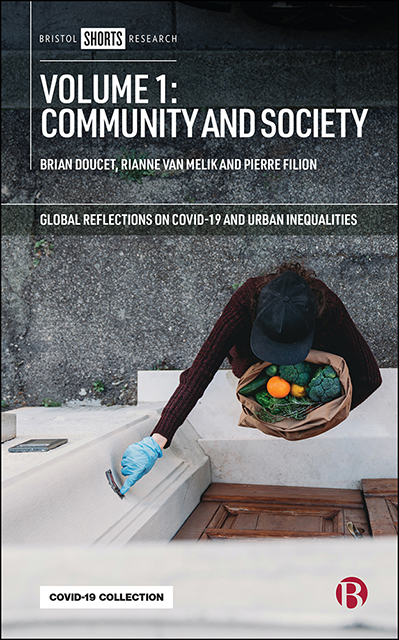Book contents
- Frontmatter
- Contents
- List of Figures and Tables
- Notes on Contributors
- Acknowledgments
- Preface to All Four Volumes of Global Reflections on COVID-19 and Urban Inequalities
- One Introduction
- Part I Working Practices
- Part II Life During Lockdown
- Part III Migration, Migrants, and Refugees
- Part IV Age, Race, Gender, and Ability
- Index
Six - Looking at Urban Inequalities Regarding Different Jobs in the Age of COVID-19: Who Stayed at Home, Who Did Not?
Published online by Cambridge University Press: 13 April 2023
- Frontmatter
- Contents
- List of Figures and Tables
- Notes on Contributors
- Acknowledgments
- Preface to All Four Volumes of Global Reflections on COVID-19 and Urban Inequalities
- One Introduction
- Part I Working Practices
- Part II Life During Lockdown
- Part III Migration, Migrants, and Refugees
- Part IV Age, Race, Gender, and Ability
- Index
Summary
Introduction
The diverging trajectories in economic activities stemming from pandemic prevention measures (such as working from home directives) continues to affect sectors and employees worldwide in different ways (see Shearmur et al, Volume 4). According to data from the June 2020 Global Economic Prospects Report, in the best-case scenario, the COVID-19 pandemic pushed 71 million people below the poverty line, drawing the extreme poverty rate to 8.82 percent (World Bank, 2020). Although lockdowns impacted almost all sectors, those impacts varied across employment and economic sectors. A study conducted in the United States revealed that some sectors, such as trade, passenger transport, arts and entertainment, accommodation, food and beverage, and other personal services, were comparatively more affected. Some occupational groups working in different positions within these sectors were also affected in different ways. Employees in these sectors are younger and less well-educated, with lower annual income, thus making them economically less secure during the COVID-19 pandemic (Berube and Bateman, 2020).
The pandemic has deepened inequalities, both in terms of the economic loss (dependent to some extent on the ability or inability to work from home) and the disease risk to those who continue to go to work. Frontline workers in health care and critical supply chains continue to work under the risk of infection, although they are less financially affected (Bergamini, 2020). While economic activities have slowed down worldwide, the capacity to work remotely determines the extent of the economic costs caused by the pandemic. The ability to work remotely depends on the nature of the jobs and employees. For example, academics may continue working in distance education, whereas employees at the same universities who provide catering services, stationery supplies, and so on may be adversely affected (OECD, 2020). According to statistics put forward in the United States, there is a strong relationship between income percentiles and rates of working from home. While the employees at the bottom of the income percentiles (bottom 25 percent) can work from home at a rate of 9.2 percent, this rate rises to 61.5 percent in the top quintile (top 25 percent) (Bergamini, 2020).
According to the OECD report, which evaluated the capabilities of remote work, the capacity to work from home in Turkey is around 21 percent, while it is 30 percent in Istanbul, the country's largest city (OECD, 2020).
- Type
- Chapter
- Information
- Volume 1: Community and Society , pp. 61 - 70Publisher: Bristol University PressPrint publication year: 2021



